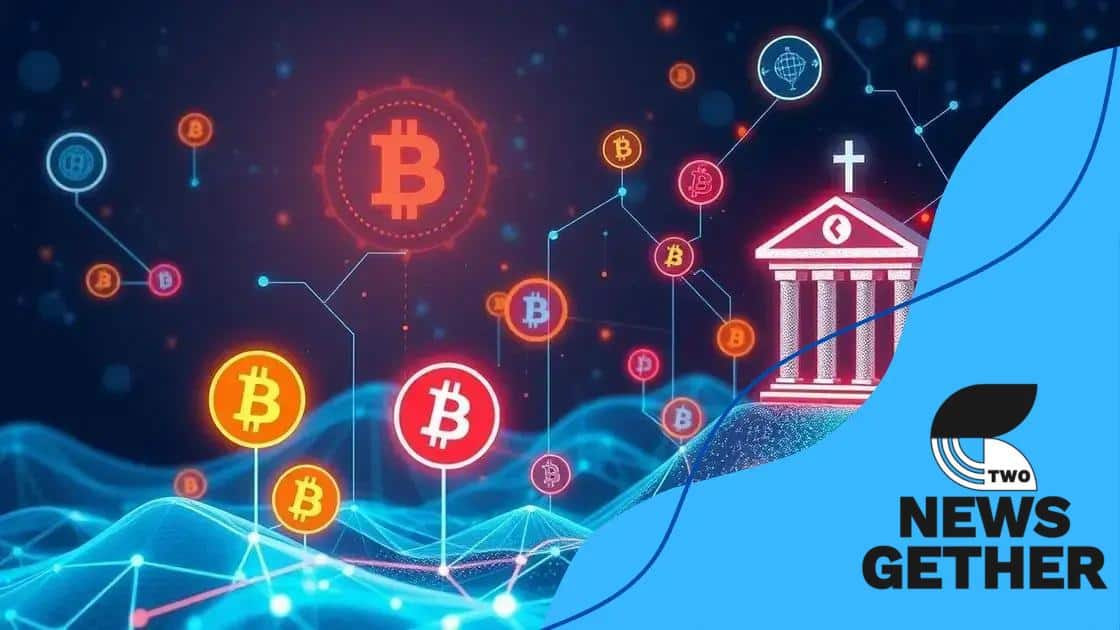How DeFi is disrupting traditional finance trends

DeFi (Decentralized Finance) is revolutionizing traditional finance by offering accessible, transparent, and lower-cost financial services through blockchain technology, while also presenting risks like market volatility and smart contract vulnerabilities.
How DeFi (Decentralized Finance) is disrupting traditional finance is a question many are asking today. This financial revolution offers new opportunities that could change how we handle money. Are you ready to dive into this fascinating world?
Understanding DeFi and its principles
Understanding DeFi is crucial in today’s financial landscape. As traditional finance continues to evolve, the emergence of decentralized finance offers a fresh perspective on how we manage and interact with our money. DeFi empowers individuals by eliminating the need for intermediaries like banks, creating a system that is open to everyone.
At its core, DeFi is built on blockchain technology. This means that all transactions are secure and transparent, allowing users to trust the process without relying on a central authority. By utilizing smart contracts, DeFi platforms automate processes, ensuring that agreements are executed exactly as intended.
Key Principles of DeFi
Several principles underpin the functionality and appeal of DeFi:
- Decentralization: Control is distributed among users, reducing the risk of manipulation and fraud.
- Accessibility: Anyone with an internet connection can participate, irrespective of their background or location.
- Transparency: All transactions are recorded on the blockchain, allowing for easy verification.
- Interoperability: Different DeFi projects can work together seamlessly, enhancing user experience.
Moreover, DeFi has significantly lowered barriers to entry for investment and lending. Individuals can now earn interest on their crypto assets or take out loans without the hassle of credit checks. This shifting dynamic invites users to explore various opportunities that were once limited to traditional finance.
As we delve deeper into the world of DeFi, it’s vital to grasp its implications for the future of finance. The integration of innovative financial services can help individuals take charge of their financial journey. With tools that allow for personalized finance solutions, users can make informed decisions tailored to their needs.
Key differences between DeFi and traditional finance
The key differences between DeFi and traditional finance are essential to understand as they define the future of how we manage finance. Traditional finance operates through centralized institutions, while DeFi uses decentralized networks. This foundational difference creates various implications for users.
One major distinction is the way transactions are processed. In traditional finance, transactions often take time due to manual reviews and intermediaries like banks. In contrast, DeFi transactions are executed almost instantly via smart contracts on the blockchain. This speed can significantly enhance user experience.
Transparency vs. Opacity
Another critical difference lies in transparency. In DeFi, users can see all transactions on the blockchain, promoting trust among participants. This level of transparency is often lacking in traditional finance, where processes can be opaque, making it hard for users to track funds.
- Fees: DeFi typically has lower transaction fees due to fewer intermediaries.
- User Control: Users maintain full control of their funds in DeFi, unlike in traditional finance, where banks hold custody.
- Access: DeFi is accessible to anyone with an internet connection, while traditional finance may impose restrictions based on credit history.
Additionally, the approach to risk management differs. Traditional finance often relies on credit scores to determine eligibility for various financial services. In DeFi, users are evaluated based on the collateral they provide, which can lower barriers for entry for many individuals.
In the rapidly evolving financial landscape, understanding these differences can help users make informed choices. As more people explore the benefits of DeFi, the demand for traditional finance may shift, forcing institutions to adapt.
The role of smart contracts in DeFi

The role of smart contracts in DeFi is fundamental to its operation and appeal. Smart contracts are self-executing agreements with the terms directly written into code. This technology allows for trustless transactions, where users do not need to rely on a central authority to enforce the agreement.
Smart contracts automate processes that traditionally required human intervention, significantly enhancing efficiency. For example, when a user wants to lend funds, a smart contract can instantly execute the terms of the loan agreement without any delays.
Key Features of Smart Contracts
Several key features make smart contracts vital in the DeFi ecosystem:
- Immutability: Once a smart contract is deployed on the blockchain, it cannot be changed. This feature ensures that agreements remain tamper-proof.
- Transparency: Smart contracts are visible to all participants in the network, allowing anyone to review the terms and conditions.
- Cost Efficiency: Automating transactions reduces costs associated with intermediaries, making financial services cheaper for users.
- Accessibility: Anyone can create or interact with smart contracts, promoting financial inclusivity.
Moreover, smart contracts facilitate complex financial transactions. They can manage multi-signature wallets, automate yield farming, and enable decentralized exchanges to operate seamlessly. These capabilities open new avenues for users to interact within the DeFi space.
The flexibility of smart contracts means they can be programmed for various use cases. Developers can design contracts for lending, borrowing, trading, and more. Each interaction is secure and transparent, thereby enhancing user trust.
Risks and challenges associated with DeFi
Understanding the risks and challenges associated with DeFi is crucial for anyone looking to participate in this innovative financial landscape. While DeFi provides many opportunities, it also comes with inherent risks that users must be aware of.
One significant risk is the potential for smart contract vulnerabilities. Even though smart contracts are designed to be secure, coding errors or exploits can lead to loss of funds. This is especially concerning since once transactions are executed, they cannot be reversed.
Common Risks in DeFi
Some common risks that users may encounter include:
- Market Volatility: Cryptocurrency prices can fluctuate significantly, impacting the value of assets held in DeFi platforms.
- Liquidity Risk: Certain DeFi projects may face liquidity issues, making it challenging to withdraw funds when needed.
- Regulatory Uncertainty: As governments navigate the complexities of blockchain technology, new regulations could impact how DeFi operates, potentially affecting users.
- Scams and Fraud: The decentralized nature of DeFi can attract bad actors who create fake projects to scam users.
Additionally, the lack of user support in DeFi systems can pose a challenge for many participants. Unlike traditional finance, where institutions offer customer service, users often have to rely on community resources or forums for help.
It’s also important to note that DeFi operates on decentralized exchanges that may not have the same protective measures as traditional platforms. This increased risk can deter users who are more familiar with conventional financial services. Understanding these challenges allows individuals to navigate the DeFi landscape more effectively.
Future trends in decentralized finance
The future trends in decentralized finance are shaping the way we think about money and financial systems. As technology progresses, we can expect to see significant changes in how DeFi operates and the opportunities it provides to users.
One emerging trend is the integration of artificial intelligence (AI) into DeFi platforms. AI can analyze vast amounts of data quickly, helping users make better investment decisions. This trend will likely lead to more personalized financial services, tailored to individual user needs.
Key Trends to Watch
Several key trends are set to impact the DeFi landscape in the coming years:
- Interoperability: Future DeFi protocols will increasingly focus on cross-chain functionality, allowing different blockchain networks to communicate and work together seamlessly.
- Sustainable Finance: The emphasis on eco-friendly projects may lead to green DeFi initiatives that prioritize sustainability and reduce energy consumption.
- Regulatory Clarity: As DeFi continues to grow, more regulatory frameworks may emerge, offering support and protection for users while ensuring compliance with global laws.
- Improved User Experience: User-friendly interfaces and enhanced security features will likely become standard, making DeFi more accessible to everyday users.
Additionally, DeFi staking and yield farming will continue to grow in popularity, providing users with attractive investment options. As platforms improve liquidity and security, more users will be encouraged to invest, leading to a more robust ecosystem.
The future of DeFi is dynamic and full of potential. By keeping up with these trends, individuals can stay informed and make smart choices in their financial journeys.
FAQ – Frequently Asked Questions about DeFi
What is DeFi?
DeFi, or decentralized finance, refers to financial systems built on blockchain technology that operate without traditional intermediaries, allowing users to manage their assets directly.
What are the main benefits of using DeFi?
DeFi offers benefits such as increased accessibility, greater transparency, and lower transaction fees, empowering users to take control of their finances.
What risks should I be aware of when using DeFi?
Users should be cautious of smart contract vulnerabilities, market volatility, and the potential for scams within decentralized platforms.
How is the future of DeFi expected to evolve?
The future of DeFi is likely to include trends such as artificial intelligence integration, enhanced user experiences, and regulatory clarity to support safe and sustainable growth.






